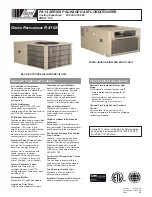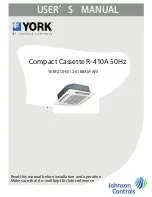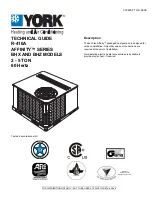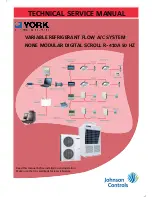
SERVICING
41
LOW SIDE
GAUGE
AND VALVE
HIGH SIDE
GAUGE
AND VALVE
TO
UNIT SERVICE
VALVE PORTS
VACUUM PUMP
VACUUM PUMP
ADAPTER
800 PSI
RATED
HOSES
CHARGING
CYLINDER
AND SCALE
EVACUATION
3. If the vacuum pump is working properly, close the valve to the
vacuum thermocouple gauge and open the high and low side
valves to the high vacuum manifold set. With the valve on the
charging cylinder closed, open the manifold valve to the cylin-
der.
4. Evacuate the system to at least 29 inches gauge before open-
ing valve to thermocouple vacuum gauge.
5. Continue to evacuate to a maximum of 250 microns. Close
valve to vacuum pump and watch rate of rise. If vacuum does
not rise above 1500 microns in three to five minutes, system
can be considered properly evacuated.
6. If thermocouple vacuum gauge continues to rise and levels off
at about 5000 microns, moisture and non-condensables are
still present. If gauge continues to rise a leak is present. Re-
pair and re-evacuate.
7. Close valve to thermocouple vacuum gauge and vacuum pump.
Shut off pump and prepare to charge.
S-103
CHARGING
WARNING
REFRIGERANT UNDER PRESSURE!
* Do not overcharge system with refrigerant.
* Do not operate unit in a vacuum or at negative
pressure.
Failure to follow proper procedures may cause
property damage, personal injury or death.
CAUTION
Use refrigerant certified to AHRI standards. Used
refrigerant may cause compressor damage. Most
portable machines cannot clean used refrigerant
to meet AHRI standards.
Operating the compressor with the suction valve
closed will cause serious compressor damage.
Charge the system with the exact amount of refrigerant.
Check the unit nameplates for the correct refrigerant charge.
An inaccurately charged system will cause future problems.
1. When using an ambient compensated calibrated charging cyl-
inder, allow liquid refrigerant only to enter the high side.
2. After the system will take all it will take, close the valve on the
high side of the charging manifold.
3. Start the system and charge the balance of the refrigerant
through the low side.
NOTE: R410A should be drawn out of the storage container or
drum in liquid form due to its fractionation properties, but should
be "Flashed" to its gas state before entering the system. There are
commercially available restriction devices that fit into the sys-
tem charging hose set to accomplish this.
DO NOT
charge liquid
R410A into the compressor.
4. With the system still running, close the valve on the charging
cylinder. At this time, you may still have some liquid refriger-
ant in the charging cylinder hose and will definitely have liq-
uid in the liquid hose. Reseat the liquid line core. Slowly open
the high side manifold valve and transfer the liquid refriger-
ant from the liquid line hose and charging cylinder hose into
the suction service valve port. CAREFUL: Watch so that liquid
refrigerant does not enter the compressor.
FINAL CHARGE ADJUSTMENT
The outdoor temperature must be 65°F to 105°F. If outdoor ambi-
ent temperature is out of range, charge defined amount and don't
adjust subcooling. Set the room thermostat to CHARGE MODE.
After system has stabilized per startup instructions, check
subcooling as detailed in the following section.
In the event of system overcharge or undercharge, refrigerant
in the system must be adjusted to the appropriate subcooling
and superheat as specified in the following sections. Refrig-
erant amount should be adjusted /- 0.5 lb. if the out-
door ambient temperature is greater than 65°F and less than
105°F. Manufacturer recommends that the system should be
evacuated and should be charged the initial refrigerant for
given line length when the ambient temperature is less than
65°F and more than 105°F. Refer to S-120 to calculate refriger-
ant amount.
















































